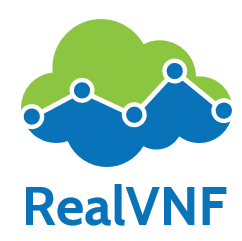Using deep reinforcement learning (with DDPG), for online service coordinating, including scaling and placement of services and scheduling of rapidly incoming flows. Services consist of chained components that need to be instantiated at nodes in the substrate network and that incoming flows need to traverse in a predefined order. Our approach learns how to do this by itself just from experience, optimizing individual objectives (e.g., flow success rate) or multiple, even competing objectives (e.g., throughput, QoS, energy, costs). It works with realistically available monitoring information, containing partial and delayed observations of the full network state.
For a quick start, check out our Quick Start Notebook:
If you use this code, please cite our conference paper (Best Student Paper at IEEE/IFIP CNSM 2020) and journal paper:
@inproceedings{schneider2020selfdriving,
title={Self-Driving Network and Service Coordination Using Deep Reinforcement Learning},
author={Schneider, Stefan and Manzoor, Adnan and Qarawlus, Haydar and Schellenberg, Rafael and Karl, Holger and Khalili, Ramin and Hecker, Artur},
booktitle={International Conference on Network and Service Management (CNSM)},
year={2020},
publisher={IFIP/IEEE}
}
@article{schneider2021selflearning,
title={Self-Learning Multi-Objective Service Coordination Using Deep Reinforcement Learning},
author={Schneider, Stefan and Khalili, Ramin and Manzoor, Adnan and Qarawlus, Haydar and Schellenberg, Rafael and Karl, Holger and Hecker, Artur},
journal={Transactions on Network and Service Management (TNSM)},
volume={18},
number={3},
year={2021},
publisher={IEEE}
}
You need to have Python 3.6 or 3.7 and venv module installed.
The installation was tested locally and works on Ubuntu 16.04 and 20.04 with Python 3.6 and coord-sim v2.1.0.
Newer changes are only tested on Python 3.7 by the GitHub CI (which does not support Python 3.6 anymore).
DeepCoord does not work with Python 3.8 because tensorboard 1.14.0, which is a required dependency, is not available for Python 3.8.
On your local machine:
# check version
python3 --version
# if not 3.6 or 3.7, install python 3.6
sudo apt update
sudo add-apt-repository ppa:deadsnakes/ppa
sudo apt install python3.6 python3.6-dev python3.6-venv
# create venv once
python3.6 -m venv ./venv
# activate the venv (always)
source venv/bin/activate
# update setuptools
pip install -U setuptoolsDeepCoord is available on PyPI, but we recommend installing it from source:
# from within the repo directory
pip install -e .This also installs the required coord-sim simulation environment.
All options:
$ deepcoord -h
Usage: deepcoord [OPTIONS] AGENT_CONFIG NETWORK SERVICE SIM_CONFIG STEPS
deepcoord cli for learning and testing
Options:
--seed INTEGER Specify the random seed for the environment and
the learning agent.
-t, --test TEXT Name of the training run whose weights should
be used for testing.
-w, --weights TEXT Continue training with the specified weights
(similar to testing)
-a, --append-test Append a test run of the previously trained
agent.
-v, --verbose Set console logger level to debug. (Default is
INFO)
-b, --best Test the best of the trained agents so far.
-ss, --sim-seed INTEGER Set the simulator seed
-gs, --gen-scenario PATH Diff. sim config file for additional scenario
test
-h, --help Show this message and exit.Ignore potential tensorflow warnings.
Example for short training then testing:
deepcoord res/config/agent/sample_agent.yaml res/networks/sample_network.graphml res/service_functions/abc.yaml res/config/simulator/sample_config.yaml 10 --append-testResults are stored under results/ according to the input arguments and the current time stamp.
There, you'll find copies of the used inputs, the trained weights, logs, and all result files of any test runs that you performed with these weights.
If you get a FileNotFoundError for the result file, it is possible that the file path is too long under Windows (see #16).
Then you can solve the error by renaming your files to have shorter filenames.
To run another test run with the trained weights, specify the <timestamp_seed> of the training run. For testing, it is recommended to use 200 steps as it is the duration of one episode and use -e to specify the number of testing episodes.
For example:
deepcoord res/config/agent/sample_agent.yaml res/networks/sample_network.graphml res/service_functions/abc.yaml res/config/simulator/sample_config.yaml 200 -t <timestamp_seed> -e 1To train an agent and test it on multiple scenarios (simulator configurations), use the -gs to specify a different simulator config file to test in combination with --append-test.
Example for testing with generalization:
deepcoord res/config/agent/sample_agent.yaml res/networks/sample_network.graphml res/service_functions/abc.yaml res/config/simulator/sample_config.yaml 1000 --append-test -gs res/config/simulator/sample_config.yamlTo view the learning curve of all agents, i.e., the episode reward over time, use tensorboard:
tensorboard --logdir==./graphYou can also filter to only show curves of a specific agent config, network (and service and config) by setting the --logdir correspondingly:
tensorboard --logdir==./graph/<agent_config>/<network>/<service>/<simulator_config>To get a better understanding of what the agent is doing, there is an Juypter notebook eval_example.ipynb.
It's just an example; you won't be able to run it without all the results (which are too large for the repo).
To create a similar notebook for evaluation:
# first time installation
pip install -r eval_requirements.txt
# run jupyter server
jupyter labNote: If you're running on the server, you should start the Jupyter server in a screen with the following command:
jupyter notebook --ip 0.0.0.0 --no-browserYou can then access it over the server's URL at port 8888 at the /lab endpoint. For authentication, copy and paste the token that is displayed whed starting the Jupyter server.
Additionally, the coord-sim simulator provides the option to generate animations of the learned policy:
See coord-sim Readme.
There is script provided in the scripts folder that utilizes the GNU Parallel utility to run multiple agents at the same time to speed up the training process.
./scripts/run_parallel.shTo run long training sessions in remote environments without risking to stop the sessions due to possible connectivity issues, it is recommended to run the experiments with the screen linux tool.
- For that, start a new
screenwithscreen -S rl-parallel. - Configure the agent and the network, service, config files in the
scriptsdirectory to match the scenarios that you want to run. Here, the lines of network, service, config are matched by lines (not all permutations), eg, 1. network is matched with 1. service and 1. config. Then all seeds are used for all scenarios. - Inside the screen, with the venv activated, run
./scripts/run_parallel.shfrom the project root.
This project has received funding from German Federal Ministry of Education and Research (BMBF) through Software Campus grant 01IS17046 (RealVNF).




